This comprehensive guide will provide you with all the information you need to successfully grow Cryptocoryne Parva in your aquarium.
From understanding its distinctive features to creating the perfect environment and maintaining optimal water conditions, this guide will equip you with the knowledge and techniques to ensure the lush growth of Cryptocoryne Parva in your tank.
We will also cover propagation, common issues, and integration into your aquarium community.
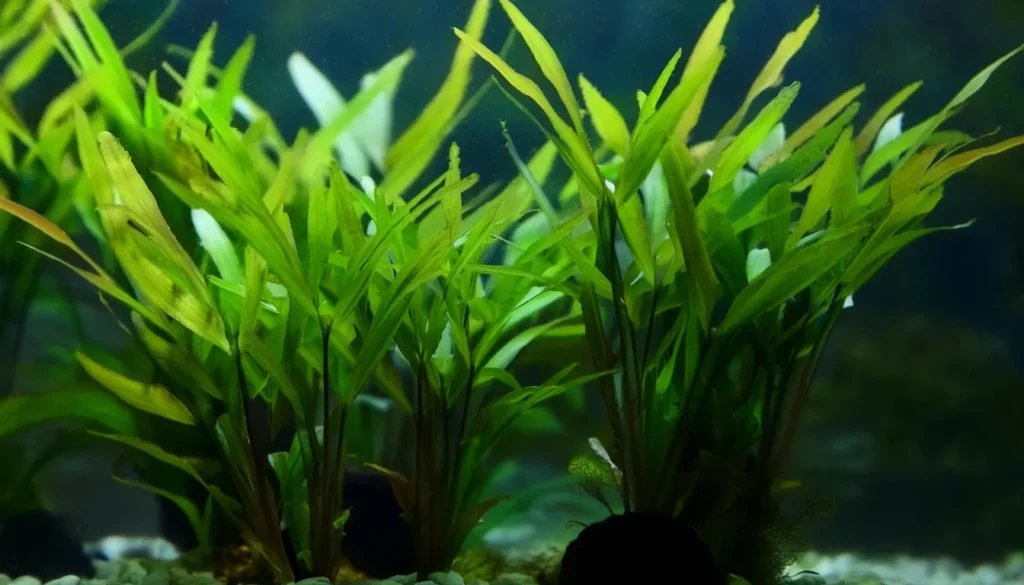
Key Takeaway
- Proper care and understanding of Cryptocoryne Parva are essential for successful cultivation.
- Creating the perfect environment with optimal water parameters and substrate is crucial for healthy growth.
- Proper lighting and nutrient supplementation play a significant role in promoting lush carpet-like growth.
- Understanding propagation methods and troubleshooting common issues will help you maintain a thriving Cryptocoryne Parva carpet.
- Integrating Cryptocoryne Parva with compatible plants and fish will create a balanced and visually appealing aquarium ecosystem.
Quick Stats
| Attribute | Details |
| Family Name | Araceae |
| Origin | Sri Lanka |
| Height | 3-10 cm (1-4 inches) |
| pH Range | 6.0 – 7.5 |
| CO2 Requirement | Low to Moderate |
| Growth Rate | Very Slow |
| Care Level | Moderate |
| Color Form | Bright Green |
| Water Conditions | 22-28°C (72-82°F), adaptable to a wide range of hardness |
| Max Size | Up to 10 cm (4 inches), usually stays smaller |
| Lighting | Moderate to High |
| Supplements | Benefits from root tabs and liquid fertilizers |
| Placement | Foreground |
| Propagation | By runners |
What Is Cryptocoryne Parva?
Cryptocoryne Parva, also known as Dwarf Water Trumpet, is a species of aquatic plant native to Sri Lanka.
It belongs to the Cryptocoryne genus and is a popular choice for aquarium enthusiasts due to its compact size and lush growth.
Cryptocoryne Parva has distinct features that set it apart from other aquatic plants, making it an excellent choice for creating a carpet effect in the foreground of your aquarium.
Natural Habitat And Origin
Cryptocoryne parva originates from the tropical regions of Sri Lanka, specifically found in marshy areas, streams, and riverbanks.
It is part of the Aroid family and naturally grows in shallow, slow-moving waters with sandy or gravelly substrates.
In its native habitat, Cryptocoryne parva typically grows emersed during the dry season and submersed when water levels rise during the wet season.
The plant thrives in warm, humid conditions with ample sunlight, making it well-adapted to the tropical climate of Sri Lanka.
RELATED: How To Plant Ceratopteris Siliquosa In Your Aquarium?
Physical Characteristics
- Small Size: Cryptocoryne Parva is known for its compact size, making it an ideal choice for foreground planting. Its petite stature allows for easy integration into any aquarium setup.
- Green Coloration: This aquatic plant exhibits vibrant green coloration, adding a refreshing and natural touch to your underwater landscape. The lush green leaves are visually appealing and create a soothing ambiance in the aquarium.
- Rosette Growth Pattern: Cryptocoryne Parva grows in a rosette pattern, forming a dense carpet-like structure. The leaves emerge from a central stem, creating a compact and visually striking arrangement.
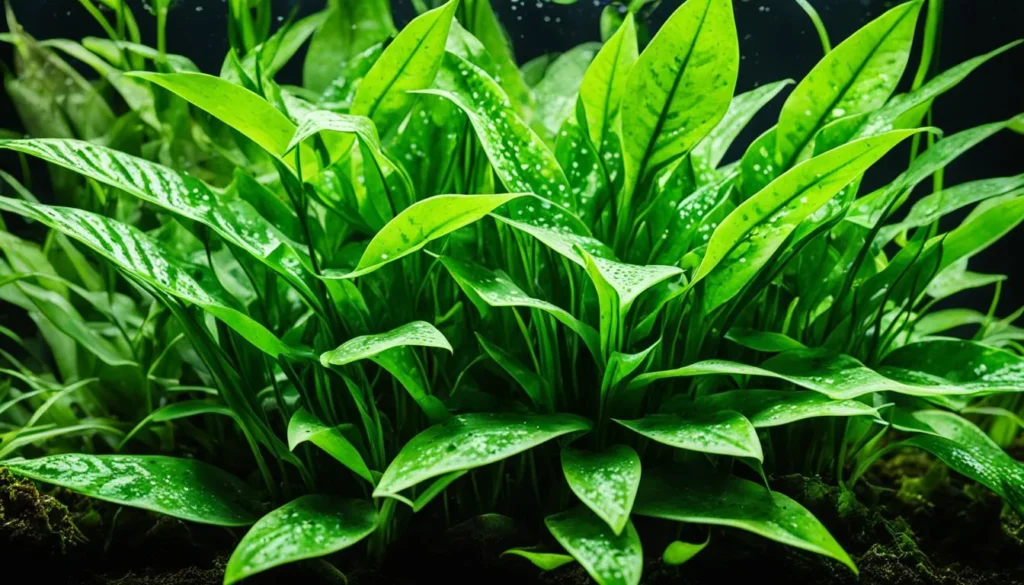
Temperature And pH Levels
- The ideal temperature range for Cryptocoryne Parva is between 72°F and 82°F (22°C and 28°C). This temperature range mimics the plant’s natural habitat, promoting healthy growth and metabolic activities.
- Regarding pH levels, Cryptocoryne Parva thrives in slightly acidic to neutral water conditions. To provide an optimal environment for your plants, aim for a pH range of 6.0 to 7.5.
- Maintaining stable temperature and pH levels is crucial to prevent stress or fluctuations that can adversely affect the health of your Cryptocoryne Parva. Regular monitoring with a reliable thermometer and pH test kit is recommended.
Water Hardness
- Water hardness refers to the mineral content in the water, particularly the concentration of calcium and magnesium ions. Cryptocoryne Parva prefers soft to moderately hard water with a hardness range of 2 to 10 dGH (degrees of General Hardness).
- Soft water with lower mineral content is generally more suitable for the growth and health of Cryptocoryne Parva. If your water source is hard, you can consider using reverse osmosis (RO) water or a water conditioner specifically formulated to reduce hardness.
- By maintaining optimal water conditions in terms of temperature, pH levels, and water hardness, you can provide an ideal environment for the health and growth of your Cryptocoryne Parva.
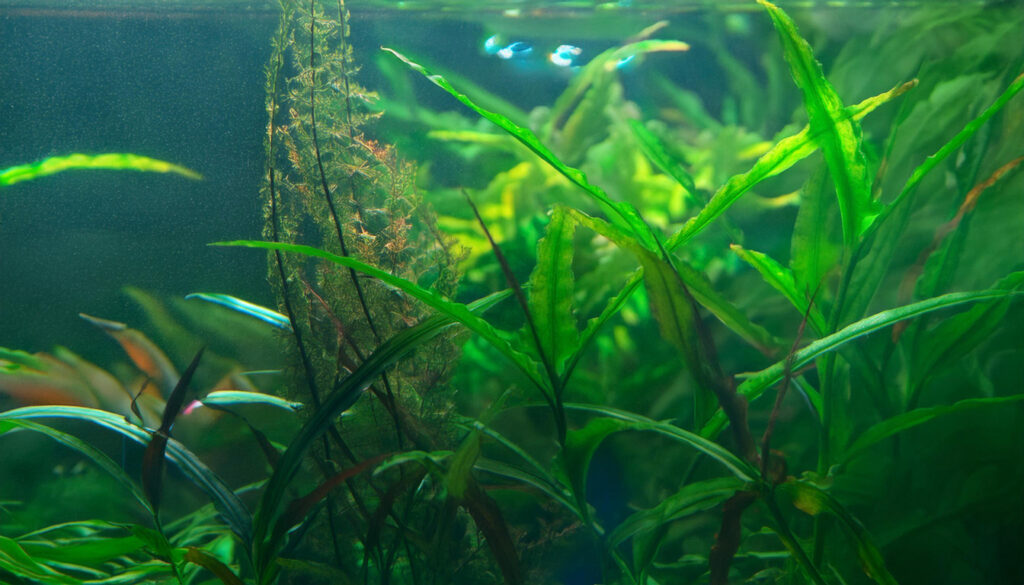
Importance Of Proper Lighting
- Proper lighting is crucial for Cryptocoryne Parva’s photosynthesis process and overall health. Providing the right amount and intensity of light is essential to supporting the growth and well-being of this species in your aquarium.
- Lighting plays a vital role in the photosynthesis process, where plants convert light into energy for growth and development. Cryptocoryne Parva requires an appropriate lighting setup to ensure optimal photosynthesis and healthy foliage.
- When choosing lighting for your aquarium, consider factors such as light duration, light spectrum, and light intensity. Cryptocoryne Parva thrives under moderate to high light conditions. However, it’s crucial to strike a balance and avoid excessive light, which can lead to algae growth and harm the plant.
RELATED: Crinum Calamistratum Care Guide & Tips For Beginners
The Ideal Substrate For Cryptocoryne Parva
- When it comes to selecting the ideal substrate for Cryptocoryne Parva, there are a few options to consider. One popular choice is aquarium soil, which provides a rich source of nutrients and promotes healthy root development.
- Another option is coarse sand or gravel, which allows for better water circulation and prevents debris accumulation. Whichever substrate you choose, ensure that it is fine-grained to prevent damage to Cryptocoryne Parva’s delicate roots.
- If you prefer a more natural look, you can use a plant-specific substrate such as aqua soil or specialized planting substrates enriched with nutrients. These substrates, including Cryptocoryne Parva, are specifically designed to provide optimal nutrition for aquatic plants.
- It is important to note that Cryptocoryne Parva benefits from a substrate with a high cation exchange capacity (CEC). This property allows the substrate to retain and release essential nutrients for the plants effectively. A substrate with a higher CEC will provide a steady supply of nutrients, promoting healthy growth and preventing nutrient deficiencies.
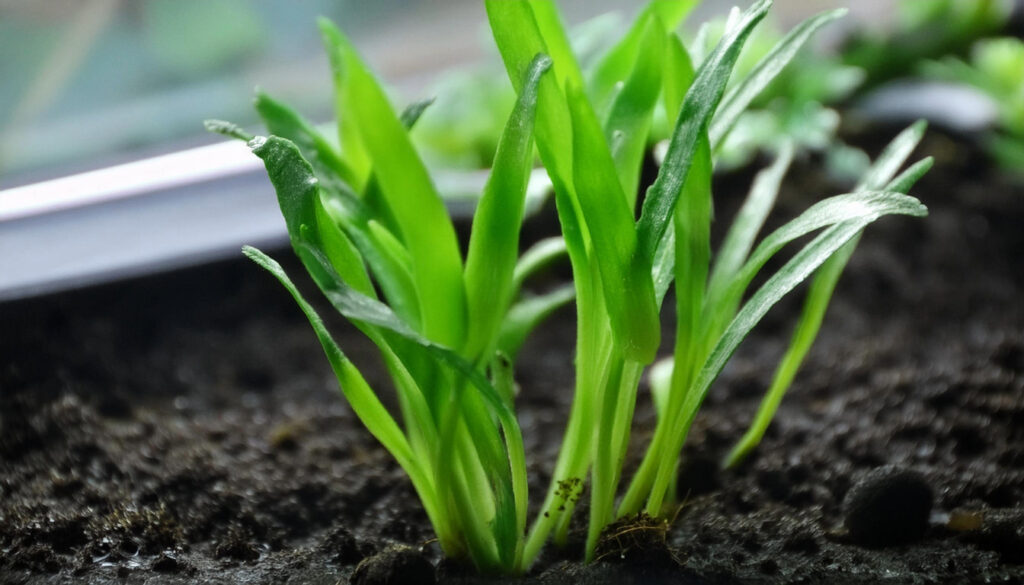
Placement In Tank
- Foreground: This plant is often used as a foreground plant due to its compact size and slow growth rate. Planting it in the foreground creates a lush carpeting effect, adding depth and dimension to the aquarium. Ensure sufficient spacing between individual plants to allow them to spread and form a dense carpet over time.
- Midground: While Cryptocoryne parva is typically used in the foreground, it can also be placed in the midground of the aquarium. Planting it in the midground adds texture and visual interest to the aquascape, especially when combined with taller background plants and hardscape elements.
- Borders: Cryptocoryne parva can be used to create natural borders or edges along pathways or open areas in the aquarium. Planting it along the edges helps define the space and softens the transition between different areas of the tank.
Recommended Tank Size
- This plant can thrive in a variety of tank sizes, ranging from small nano tanks to larger aquarium setups. However, for optimal growth and maintenance, a tank size of at least 10 gallons (approximately 38 liters) or larger is recommended.
- In smaller tanks, it can be used effectively as a foreground plant to create a lush carpeting effect. In larger tanks, it can be used as a midground or foreground plant, depending on the overall aquascape design.
- Regardless of tank size, providing stable water parameters, adequate lighting, and nutrient-rich substrate will contribute to the successful growth of Cryptocoryne parva in the aquarium. Additionally, regular maintenance and proper care are essential to ensure the plant’s health and vitality regardless of tank size.
Companion Plants And Fishes TO Coexist With Cryptocoryne Parva
- Anubias Nana: With its broad leaves and low light requirements, Anubias Nana is an excellent companion for Cryptocoryne Parva. It adds texture and depth to the aquarium, creating a beautiful contrast.
- Tetras: Many Tetra species, such as Neon Tetras and Cardinal Tetras, are peaceful fish that thrive in the same water conditions as Cryptocoryne parva. They are unlikely to disturb the plants.
- Bacopa Caroliniana: This tall and vibrant plant adds a splash of color to the background of your aquarium, complementing the lush carpet created by Cryptocoryne Parva.
- Java Fern: With its delicate and textured leaves, Java Fern creates a visually striking combination when placed near Cryptocoryne Parva. It requires similar water conditions, making it an ideal companion plant.
- Rasboras: Small, peaceful schooling fish like Harlequin Rasboras and Galaxy Rasboras enjoy the shelter provided by plants and will not harm them.
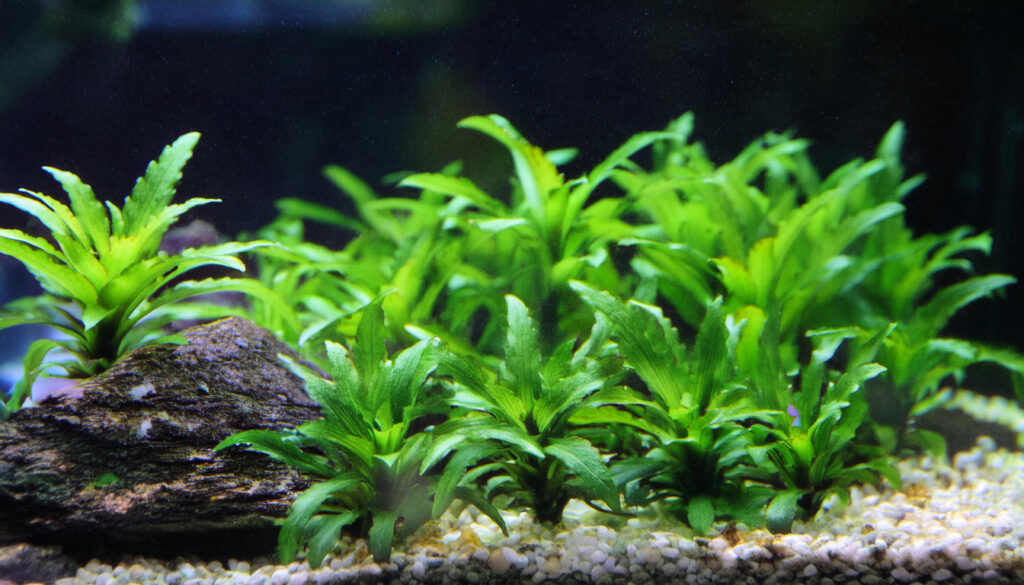
Supplementing Nutrients
- In addition to selecting the right substrate, supplementing nutrients through fertilizers is crucial for the optimal growth and nutrition of Cryptocoryne Parva. Fertilizers provide essential elements such as nitrogen, phosphorus, potassium, and trace elements necessary for healthy plant development.
- There are two main types of fertilizers to consider: liquid fertilizers and root tabs. Liquid fertilizers are added directly to the water, where the plant’s leaves and roots can easily absorb them. Root tabs, on the other hand, are placed in the substrate near the plant’s roots. They slowly release nutrients over time, ensuring a steady supply for Cryptocoryne Parva.
- When choosing a fertilizer, look for products specifically formulated for aquatic plants. These fertilizers typically contain the necessary macro and micronutrients in balanced ratios. Following the recommended dosage and schedule the manufacturer provides is important to avoid nutrient imbalances or overdosing, which can harm the plants.
RELATED: Grow Cryptocoryne Lutea For Vibrant Aquariums With This Simple Guide
Cultivation
Cultivating Cryptocoryne parva requires attention to detail during the preparation for growth, planting, and initial care stages. Here’s a step-by-step guide:
Preparing For Growth
- Choose a suitable aquarium substrate: Cryptocoryne parva prefers nutrient-rich substrates such as aquarium soil or gravel. Ensure the substrate is well-aerated and free from debris.
- Provide adequate lighting: Cryptocoryne parva thrives in moderate to low lighting conditions. Choose lighting fixtures that offer adjustable intensity to meet the plant’s needs.
- Maintain stable water parameters: Ensure the aquarium water is within the optimal temperature range of 22-28°C (72-82°F) with a slightly acidic to neutral pH (around 6.0-7.5).
Planting
- Carefully separate this plant into small individual plants or clumps. Handle the plants gently to avoid damaging the delicate roots.
- Plant the Cryptocoryne parva into the substrate, spacing them out appropriately to allow room for growth. Planting in small groups can create a more natural look.
- Ensure that the crown of each plant (where the roots meet the stem) is not buried too deeply in the substrate to prevent rotting.
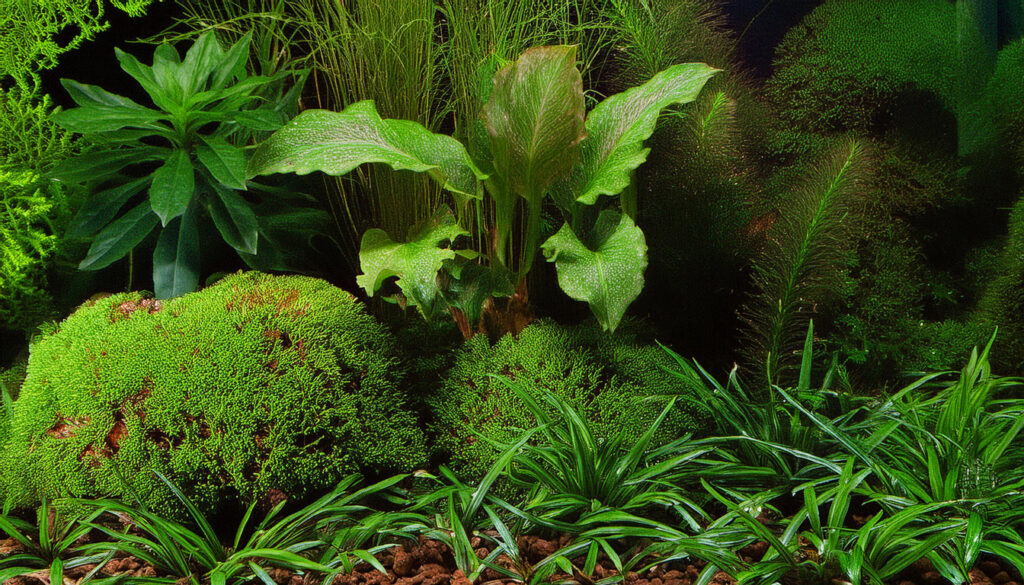
Initial Care
- Provide CO2 supplementation (if necessary): Cryptocoryne parva can benefit from CO2 supplementation, especially in high-tech planted tanks with strong lighting. CO2 injection can enhance growth and promote lush foliage.
- Fertilize the substrate: Use root tabs or liquid fertilizers specifically formulated for aquarium plants to provide essential nutrients to Cryptocoryne parva. Follow the manufacturer’s instructions for dosage and application.
- Monitor and adjust lighting: Keep an eye on the lighting intensity and duration to prevent algae growth while ensuring sufficient light for plant growth. Adjust the lighting settings as needed based on the plant’s response.
Ongoing Maintenance
- Conduct regular water changes: Perform weekly water changes to maintain water quality and remove any accumulated debris or organic matter from the substrate.
- Trim and prune as needed: Trim any dead or decaying leaves from Cryptocoryne parva to promote new growth and maintain the plant’s appearance. Prune overgrown stems to prevent shading and overcrowding.
- Monitor plant health: Keep an eye out for any signs of nutrient deficiencies, pests, or diseases. Address any issues promptly to prevent them from spreading to other plants.
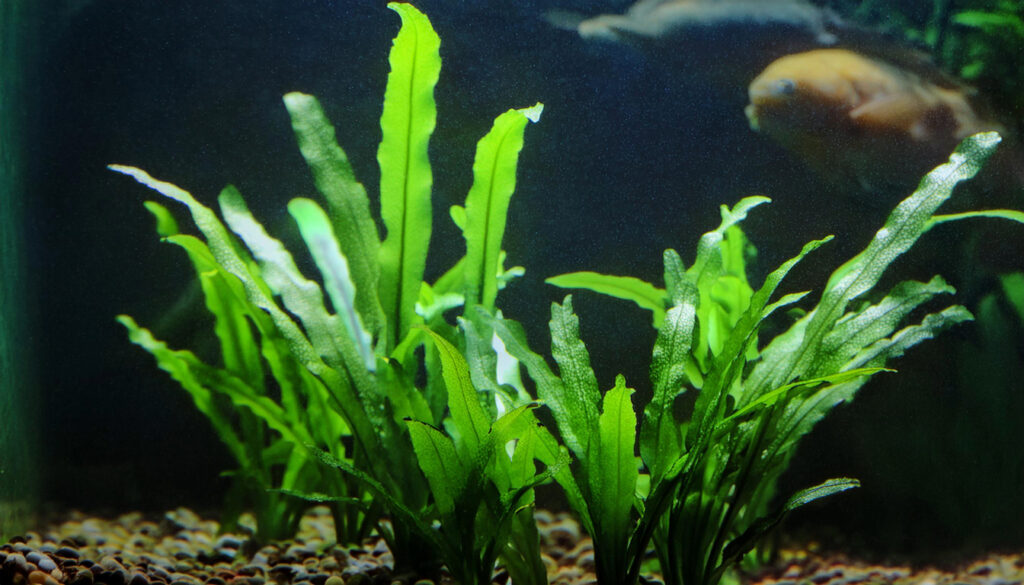
Understanding Cryptocoryne Parva Propagation
This plant, a popular aquatic plant, can be propagated through various methods to expand your carpet and create a lush aquarium scene.
In this section, we will explain each propagation method in detail, providing step-by-step instructions and helpful tips for successful propagation.
Division
To propagate Cryptocoryne Parva through division, follow these steps:
- Carefully remove the plant from the substrate, ensuring minimal damage to the roots.
- Gently separate the plant into smaller clumps, each with its own root system.
- Plant the divided clumps into the desired areas of your aquarium, ensuring proper spacing for future growth.
- Provide adequate lighting, nutrients, and water conditions for the newly divided plants to establish and grow.
Runners
Cryptocoryne Parva produces runners, which are horizontal stems that develop new plantlets. Follow these steps to propagate through runners:
- Identify the plantlets growing from the runners.
- Gently detach the plantlets from the runner using clean, sharp scissors or a scalpel.
- Plant each plantlet into the substrate, ensuring their roots are properly buried.
- Provide optimal lighting conditions and regularly monitor water parameters to promote healthy growth.
Tissue Culture
Tissue culture is another method of propagating Cryptocoryne Parva. Here’s how:
- Obtain a tissue-cultured Cryptocoryne Parva plant from a reputable supplier.
- Rinse the plant thoroughly to remove any residual culture medium.
- Plant the tissue-cultured plant into the substrate, ensuring the roots are well-buried.
- Follow appropriate care guidelines for maintaining tissue-cultured plants, including proper lighting and nutrient supplementation.
Dealing With Algae
Algae growth is a common concern for aquarium plant enthusiasts.
Algae can affect your tank’s aesthetic appeal and compete with Cryptocoryne Parva for nutrients and sunlight.
To combat algae, here are some strategies you can implement:
- Ensure proper lighting: Adjust the duration and intensity of your aquarium lights to meet the needs of Cryptocoryne Parva while discouraging excess algae growth.
- Limit nutrient availability: Algae thrive on excessive nutrients, so monitor and control nutrient levels in your aquarium by maintaining a balanced fertilization routine.
- Perform regular maintenance: Clean your aquarium, remove any decaying organic matter, and trim any affected leaves or algae-infested plants.
- Introduce algae-eating species: Consider adding algae-eating fish or invertebrates to your tank, such as Siamese algae eaters or Amano shrimps. These species can help control algae growth naturally.
Conclusion
Growing Cryptocoryne Parva can be a rewarding and enjoyable experience for aquarium enthusiasts.
Following the guidelines and techniques outlined in this ultimate guide, you can create a lush and thriving Cryptocoryne Parva carpet in your aquarium.
This guide has taught you to grow and care for Cryptocoryne Parva successfully, from understanding its distinctive features to providing the perfect environment and maintenance tips.
Frequently Asked Question
What Are The Ideal Substrate Requirements For Cryptocoryne Parva To Ensure Optimal Growth And Health?
This plant thrives in a nutrient-rich, fine-grained substrate that allows for easy root penetration and nutrient uptake.
A substrate mixture containing aqua soil, enriched with iron and other essential minerals, supports its slow growth rate and encourages the development of a healthy root system.
A depth of 2-3 inches (5-7.5 cm) of substrate is recommended to accommodate the plant’s root structure and facilitate anchorage.
Additionally, incorporating root tabs near the plant base can provide a direct nutrient source to support its growth.
How Does Co₂ Supplementation Affect The Growth Rate And Overall Health Of Cryptocoryne Parva?
CO₂ supplementation can significantly enhance the growth rate, density, and color vibrancy of Cryptocoryne Parva.
While this plant can grow without added CO₂, supplementation encourages more vigorous growth and can help achieve a lush, dense carpet in the aquarium more quickly.
Optimal CO₂ levels for Cryptocoryne Parva are in the range of 15-30 ppm.
It’s important to monitor CO₂ levels and adjust them carefully to avoid stressing the plant and other aquarium inhabitants.
What Specific Lighting Conditions Are Recommended For Cryptocoryne Parva To Promote Healthy Development And Prevent Algae Growth?
This plant requires moderate to high lighting to flourish, with an ideal PAR (Photosynthetically Active Radiation) value of 30-50 micromoles.
Consistent lighting for 8-10 hours per day is recommended to mimic natural light cycles and promote steady growth.
While Cryptocoryne Parva can tolerate lower light levels, insufficient lighting can slow its growth even further and make it susceptible to algae overgrowth on its leaves.
It’s essential to find a balance that supports plant growth without encouraging algae.
Can Cryptocoryne Parva Be Used Effectively In Aquascaping, And What Are Some Design Tips For Incorporating It Into Various Layouts?
This plant is an excellent plant for aquascaping, especially for creating detailed foregrounds and filling gaps between rocks and driftwood.
Its small size and slow growth make it ideal for miniature landscapes and nature-style aquariums.
For best visual impact, plant Cryptocoryne Parva in small groups or clusters, allowing space between them for growth.
Over time, these clusters will spread and form a natural-looking carpet.
Its green hue contrasts well with darker substrates and can be used to lead the eye towards a focal point in the aquascape.
What Are Common Issues Encountered When Growing Cryptocoryne Parva, And How Can These Be Addressed To Ensure Successful Cultivation?
This plant may experience “melting,” a common issue where leaves disintegrate as the plant adjusts to new water conditions or stress.
To mitigate this, acclimate the plant slowly to your aquarium conditions, and ensure stable water parameters.
Nutrient deficiencies, particularly in iron, can lead to pale or stunted growth.
Address this by using a nutrient-rich substrate and considering supplemental dosing with liquid fertilizers.
Additionally, its slow growth makes it susceptible to algae, which can be managed by controlling light levels and ensuring not to overfeed the aquarium.
Patience is key with Cryptocoryne Parva; given time and proper care, it will gradually form a beautiful carpet in the aquarium foreground.
- Unveiling The Wonders Of Riccia Fluitans In Aquascapes - August 7, 2024
- Vallisneria Gigantea Var. Guide To Care And Cultivation At Home - July 31, 2024
- Vesicularia Dubyana Care & Growth Guide Tips For Beginner Gardeners - July 30, 2024
